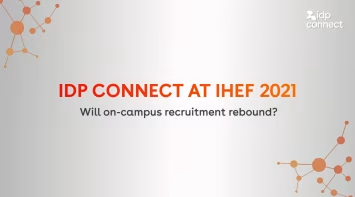As our International Education Leaders Share series continues, Dr. Ling Zhang, Director of Graduate and International Recruitment at Central Michigan University, shares her wisdom. With more than fifteen years of professional experience in the field of education and recruitment, Dr. Zhang lends her unique perspectives on the challenges facing the international student enrollment management field.

Q. When reflecting on how the pandemic has affected your institution’s recruitment of international students, what has been your greatest success and greatest regret/frustration?
A. Our greatest accomplishment is that I am now able to conduct armchair recruitment more effectively and reach out to markets that we were previously unable to access. Due to the variety of different formats and the increasing effect of screen fatigue, which can hinder information flow, we've struggled to predict the effectiveness and impact of the virtual activities we participate in. This often becomes a cause of short-term frustration.
Q. How do you now recruit digitally and nurture those student leads through the admissions process?
A. If the COVID pandemic taught us anything, it's that higher education must be ready for effective digital marketing. Determine the right platform for your targeted digital advertising campaign by first determining who your audience/market is. Second, ensure that your communication is consistent across all media and that your audience receives a consistent message. Third, evaluate the effectiveness of your marketing plan and make necessary and frequent adjustments.
Q. When you look for new tools, research, and methods to assist your planning moving forward, where do you turn?
A. Regional specialists in the subject areas, my professional network and peer group, and our worldwide partners are all resources I rely on. By combining these sources, I often receive a more detailed and nuanced view with a better perspective to direct our resources and team efforts.
Q. Are you able to develop a strategic international enrollment management plan with all the uncertainty that exists? If so, what tips would you provide to help guide those eager to start?
A. Our multi-layered international enrollment strategy is effective. Partnerships, technology, and a peer-to-peer network are all effectively leveraged. In terms of recruitment advice, I would suggest focusing on your context and assessing your particular problems and positions. With that clear evaluation in hand, seek counsel from a variety of sources. Any good plan requires a wide range of concepts.
Q. When you think about the future of international education, what does it look like to you, 5 years, 10 years from now?
International education, like most other industries, will need to adopt agile strategies. Personalized learning, facilitated by technology and real-world experiences, is, in my opinion, the future of international education. International students are looking for opportunities that will not only prepare them for the future of work but are also seeking a long-term community for networking and continuous mentorship. These elements will have to be brought together through international education.
You might like...

The World as Our Campus: Embracing a Holistic International Enrollment Strategy
An IDP 'Voice of the Sector' Piece

Peer-to-Peer: Why Student Ambassadors are Key Connections Throughout the Recruitment Funnel
A report from IDP and The Ambassador Platform

Advancing the National Conversation on International Education
IDP’s 2024 Think-Tank Event



